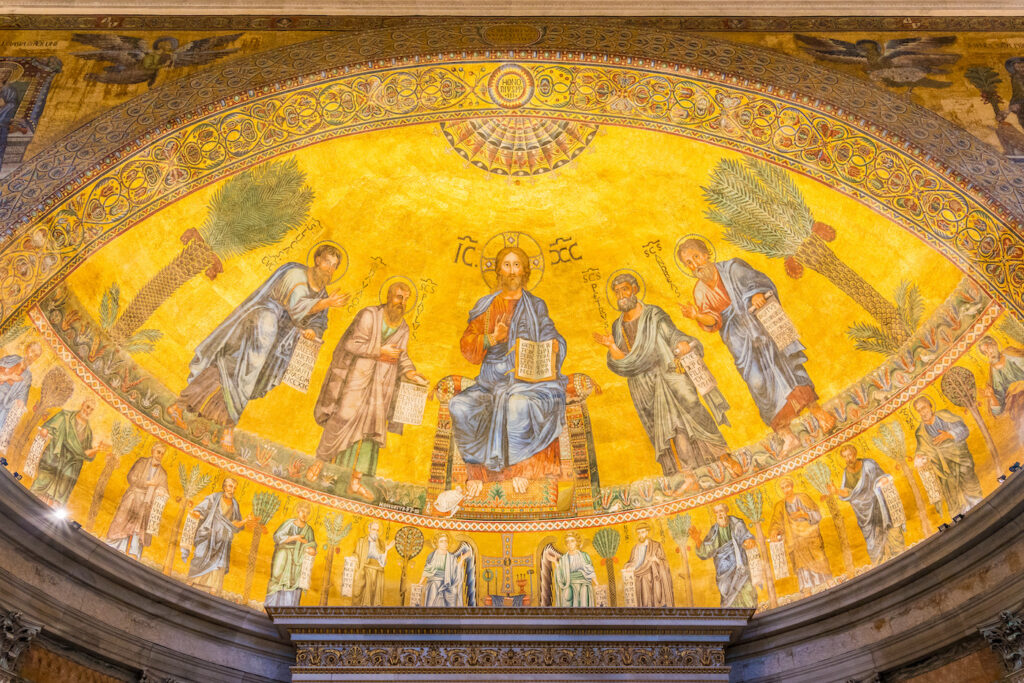Caesarius, bishop of Arles in the early sixth century, had the practice of locking the doors to his church after the congregation had assembled. In his day Christianity had not penetrated deeply in southern France, and most of the members of his flock were peasants with only a superficial grasp of the faith. It was customary for the sermon to come at the end of the Liturgy and many of the faithful would duck out before the service had ended. Caesarius wanted them present when he instructed the congregation.
This anecdote from Peter Heather’s massive and dense book Christendom: The Triumph of a Religion is one of the many fascinating details that mark its pages. Even readers who are well informed about the history of Christianity will discover that there is much to learn and to savor in Heather’s broad sweep of early and medieval Christian history.
But it is not only the breadth and depth of his account that will inform the reader. Heather wishes to dismantle some of the conventions that have governed how the story of Christian history is told. In the first of many footnotes he observes that in standard accounts of the history of Christianity there is no sense that the religion might not have been triumphant, that its success was not inevitable. Of course Christian faith did eventually overcome the many obstacles that stood in its way, and the many peoples and lands that marked its growth must color the way the story is told. Still, once the question is posed in that way, what seems obvious begins to look different.
Heather believes that the recent history of Christianity, i.e., in the twentieth century, has to be considered when assessing the early centuries. He writes: “Over the last hundred years, the Christian religion has lost its hold on the consciences of much of the population of Europe—which must necessarily make us ask more searching questions about its initial success.” This seems a stretch, and he doesn’t provide arguments to show why what came so much later can serve as a guide to interpret the early centuries. What he does highlight is the syncretism of early Christianity.
Start your day with Public Discourse
Sign up and get our daily essays sent straight to your inbox.Yet even as the number of Christians grew, traditional pre-Christian practices were seldom abandoned with the adoption of Christianity.
In Egypt in the early centuries, for example, Christian faith was adopted by many of the inhabitants. Christian religiosity expanded significantly, as Heather puts it, with many baptisms, the establishing of monasteries, an increase in the number of bishops, the use of the names of apostles and martyrs for children when baptized, and the like. Yet even as the number of Christians grew, traditional pre-Christian practices were seldom abandoned with the adoption of Christianity. Taken as a whole, writes Heather, “Christian conversion at most bolted some elements of a new religious piety onto an established world view, rather than generating any more profound reconstruction of relations between humanity and the divine.”
The old remained very much alive as the new religion established itself. As an example, the fifth-century Abbot Shenoute, one of the most heralded monastic leaders, complained that at the great White Monastery in Upper Egypt magical amulets were being produced for the general population. Significantly, animal sacrifice continued in some cities into the fifth century, during which three major works in defense of Christianity were written. What happened in Egypt was replicated as Christianity spread into other areas surrounding the Mediterranean and in northern Europe and the British Isles.
It is surely true that early Christianity was deeply syncretistic. But that is self-evident to any student of early Christian history. Heather has a larger agenda. He believes that the decline of Christianity in the twentieth century, in particular the hold of Christianity in western countries, raises questions about its success in earlier centuries. Contrary to a general perception, Christianity was not on course to dominate the Roman world. In Heather’s view, it was not the intrinsic merit of Christianity—that is, the power of the “preaching of bishops,” as he puts it—that led to Christianity’s dominance. Rather, it was the interactions of small-scale elite networks, often based on marriage, personal or political interconnections. What Christians believed is not central to the story.
It is noteworthy that in contrast to most histories of Christianity, Heather gives no account of Christian beginnings. He says nothing about the life of Jesus, or about the first followers, or the formative years when creed, liturgy, moral codes, and calendar were being formed. The book begins with the “road to Nicaea,” i.e., in the fourth century, when Christianity became a public religion identified with the emperor Constantine. The reader has no sense of how Christianity came to be, what people believed, how they lived and understood their faith. Nor do we learn anything of the thinkers who gave form to Christian belief: the writers of the New Testament, Ignatius of Antioch, Irenaeus of Lyon, Origen of Alexandria, Tertullian, and others. Christendom, as Heather conceives it, is short on ideas.
In Heather’s view, it was not the intrinsic merit of Christianity—that is the power of the “preaching of bishops,” as he puts it—that led to Christianity’s dominance. Rather, it was the interactions of small scale elite networks, often based on marriage, personal or political interconnections.
Yet once that is recognized, the book is brimming with life and energy. And it this wealth of detail that makes the book valuable as Heather takes up events, persons, institutional developments in the long period up to the fourteenth century. There is much here that is difficult to access in other forms. Take, for example, his discussion of Charlemagne and the Carolingian Empire. This story is well known and has been told in many books in recent years. Yet Heather highlights features of Charlemagne’s reform that receive attention only in specialized works—for instance, the effort to create a literary Latin language that could be used for religious books as well as legal documents necessary for a functioning Christian society.
By the eighth century classical Latin, the Latin of Cicero, Virgil, and Horace, had undergone vast changes in spelling, grammar, and vocabulary. This meant that the Scriptures read in the churches, the language of public worship, the vocabulary of the psalms, and the terminology of rituals such as baptism differed from place to place. This situation was complicated by the lack of literacy among the clergy. Since Latin is an inflected language, the use of incorrect endings of words was widespread by those who had not received a thorough grounding in Latin grammar. The aim of the Carolingian reform was to give shape to a Latin that would become standard across the western Christian world. It also meant making available earlier Christian texts, e.g., the homilies of Gregory the Great and other patristic authors, in a uniform language. Charlemagne gathered a company of scholars who in 784 presented him with two volumes of treatises and sermons of the various Catholic authors culled from earlier writings that were suitable for use throughout the year and free from errors. With such books in circulation, a standardized written Latin became available at a time when Latin was being transformed into the new vernacular languages of French, Italian, Spanish, and the like.
At the same time, a new type of script, the Carolingian minuscule, was being adopted. This process had begun in the seventh century, but it became more widely adopted under Charlemagne. Previously, texts were written in capitals without division between words. Minuscules took up less space on the page, hence documents were shorter and writing materials cost less. In time the new script became standard across the Latin world.
In chapter after chapter one is impressed by the wealth of detail. For example, Heather shows that the physical shape of religious buildings took new forms as a more penitential piety took root among the faithful. In the eleventh century, churches were equipped for the first time with baptismal fonts. This reflects the changing practice of baptism. In the early centuries, churches had baptismal pools, and adults to be baptized were immersed. But by the high middle ages, baptism was administered to infants shortly after birth, hence the need for fonts. Churches began to include bell towers to be tolled when someone died. Relics were taken on tour, and this in turn led to the growth in the number of preachers, whose penitential message attracted large numbers of followers
Christendom is a book to be cherished for its scope and encyclopedic vision of Christianity from the ancient world to the high middle ages. It is, however, not an easy read, in large measure because the sheer abundance of detail makes it difficult to maintain a strong narrative that holds things together.














